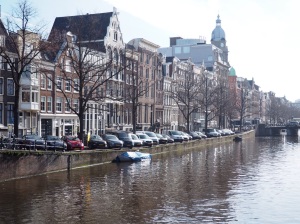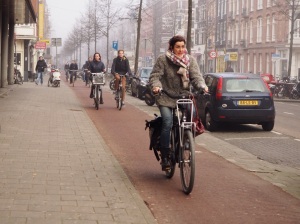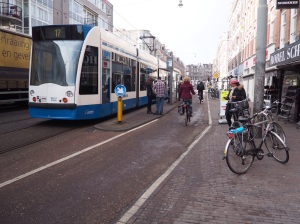Cycling Lessons Learned From Amsterdam That No One Talks About
This post originally appears on Spacing Vancouver. By Darren Proulx and Samuel Baron
I recently had the honour of visiting Amsterdam. Renowned for its cycling, Amsterdam is a city where 48% of all trips made in the city centre are by bicycle. Further, a total of 78% of trips in the region are made by walking, cycling and transit. Only 22% of trips are made by cars. This is most impressive when observe cycling closely in Amsterdam. People of all ages, dressed in everyday clothes are carrying out typical, everyday tasks by bike. Also, significantly more women are traveling by bike compared to Vancouver.
With the resurgence of cycling around the world, Amsterdam is often the subject of case studies. People assume that the Dutch operate from an elevated understanding of all things cycling. However, there have been very surprising discoveries while exploring this city. Many of these observations reveal that the Dutch are not a divine cycling culture, they opt for relatively simple designs that encourage a safer and more inviting cycling and walking environment. Below, I highlight a few of those observations.
1. Cars are still permitted even when space is limited.
Despite the high rate of people cycling, cars are still seen parked in every nook and cranny of the city. Supporting cycling does not mean that you banish the vehicle outright, you permit access for cars but tolerate them at slower speeds. This demonstrates that other cities can achieve high cycling rates while still accommodating the automobile.
2. When you don’t want cars, use barriers to keep them out.
3. Not all cycling routes are separated from vehicle traffic.
In North America there is currently a fixation on adding separated cycling lanes in every city. While it is great to finally see a movement to provide safe and convenient access for cycling, we must not assume a one size solution fits all. This type of thinking is what led us to our current state of affairs where we built big and wide to accommodate and prioritize the automobile. We must not lose sight of other tools at our disposal which can help achieve the same results.
Only 50% of the cycling routes in the Netherlands are separated from vehicular traffic. According to the C.R.O.W. Manual, the Dutch only use separated or protected cycling lanes when the traffic volumes and speeds are sufficiently high enough to pose a threat to the lives of people cycling. Alternatively, the Dutch use painted bike lanes, shared streets and woonerfs (a residential version of the shared street). In all cases, the Dutch ensure that the physical design of the street only tolerates a safe vehicle speed – they do not rely on suggestive tools such as posted speed limits.
4. Retail streets still survive and in fact thrive.
Most businesses in North America oppose adding bike lanes in front of their businesses for fear of losing driving customers. There is a misconception that customers access their business overwhelmingly by vehicle. But businesses often over estimate how many of their customers drive. The businesses in Amsterdam not only survive with a bike lane in front of their business, but they thrive as the bike lanes enliven the sidewalk and their storefronts. It is important to point out that one concern of businesses may have some merit, parking must be maintained (as explained by the next point).
5. Parking and vehicular access is provided on almost all retail streets.
With the provision of on-street parking on almost all retail streets in Amsterdam, it is clear that providing access for vehicles is still important. Parking is also critical for providing access for deliveries of supplies. This way all modes of transportation can access the businesses safely and comfortably, maximizing the potential patrons for businesses.
6. Bike lanes do not prevent crucial business deliveries.
As mentioned above, by maintaining on-street parking on retail streets, access for loading and unloading is still provided for delivery trucks without having them block traffic by double parking in the travel lane. In addition to this, large vehicles can be found in most places in Amsterdam.
7. Street widths in Amsterdam are comparable to North America.
Often, the excuse in North America is that there is no room on the streets for bike lanes. The streets in Amsterdam have comparable widths, but can still accommodate a complete street including wide sidewalks, patios, two cycling lanes, two parking lanes and two lanes of traffic. Even larger streets accommodate at least two lanes of transit and transit stops.
8. Transit stops and bike lanes can mix.
We need to stop reinventing the wheel! Often in North America bikes and buses will share a curb side lane creating a dangerous situation. People cycling are forced to overtake the bus at transit stops, which inevitably results in a bus-cycling chicken game with each constantly overtaking the other.
The Dutch have already figured out how to make cycling and transit coexist by using floating transit stops and generous sidewalks. People cycling can go around the transit stop still maintaining their dedicated right of way, while transit patrons can board and disembark the vehicle safely and efficiently.





















One thing I’d note about #1-3 is that high or low traffic volumes are planned into existence through network design. Bollards and road design speeds are important mechanisms, but they are the tip of the iceberg, only giving effect to a network plan of through-routes, filtered permeability, woonerf, winkelerf, etc., which is carefully thought out. This is what allows CROW users to exercise discretion in the treatment used on the ground.
Outside of continental Northern Europe, there seems to be a prevailing view that traffic levels — rather like market demand, as we see it — are a force of nature that cannot be contained, and therefore we can only react to it with defensive measures like barrier separation. Whenever we attempt to emulate “partial” treatments superficially, without considering the network that enables them to exist, we invariably fail. Take, for example, Exhibition Rd in London, a “shared space” modelled vaguely on Dutch practices, but which remains a through route for heavy traffic.
A greater emphasis on the network layout of streets and of de-optimising vehicle access within them — beyond an engineer’s “level of service” or functional classification hierarchy — might help us establish the same kind of platform on which to design cross-sections and intersections as the Dutch do.
LikeLike
Good article, here in Bogota – Colombia we have bycicle path network but is a mess because almost all people think that have a car is better than a bycicle but I go by bycicle all the days to work and I feel two things 1- it’s more quickly 2- It’s more healty not only for me.
Look
http://www.streetfilms.org/riding-bogotas-bountiful-protected-bikeways/
LikeLike
Have you been to Berlin? I loved how cycling and LRT work there (never been to Amsterdam yet but your article moves it higher up in my list)
LikeLike
Hii, I am Indonesian. I love cycling but our people less use it. I hope visit to Netherlands
LikeLike
> Renowned for its cycling, Amsterdam etc.
Actually, Amsterdam isn’t that great for cycling, at least downtown. For a really good example, go to Groningen.
Also, there’s a simple reason why the NL/DK, and Europe in general take cycling a bit more seriously: Europe is heavily dependent on foreign oil, and it’s getting worse since the North sea peaked around 2000.
Besides, for distances shorter than a few miles, cycling is often faster door-to-door… and more fun than being stuck in traffic and trying to find a parking space.
If if you live in a hilly area, get a pedelec (still a lot cheaper than owning a car).
LikeLike
I actually find Copenhagen has better understanding of cycling cohesion with other methods of getting around. In Amsterdam it is more an adversarial separation. You did not mention motorbikes are using their bike lanes. Pedestrians are still the lowest form of transport, if cyclist fears road in your picture bedide canal. They will ride on that sidewalk and expect pedestrians to move when they yell in Dutch. More of a black flag society than an cohesive law abiding one.
LikeLike
“In North America there is currently a fixation on adding separated cycling lanes in every city. […] Only 50% of the cycling routes in the Netherlands are separated from vehicular traffic. According to the C.R.O.W. Manual, the Dutch only use separated or protected cycling lanes when the traffic volumes and speeds are sufficiently high enough to pose a threat to the lives of people cycling. ”
Is there any evidence that there are excessive uses of protected bike lanes in US cities? I don’t think I’ve ever heard of a protected bike lane being installed in the US on a street that doesn’t have both high traffic volumes and high speeds.
LikeLike
One missing aspect is mindset. The Dutch do not have a starting mindset to get in their car for the shortest of journeys.
LikeLike